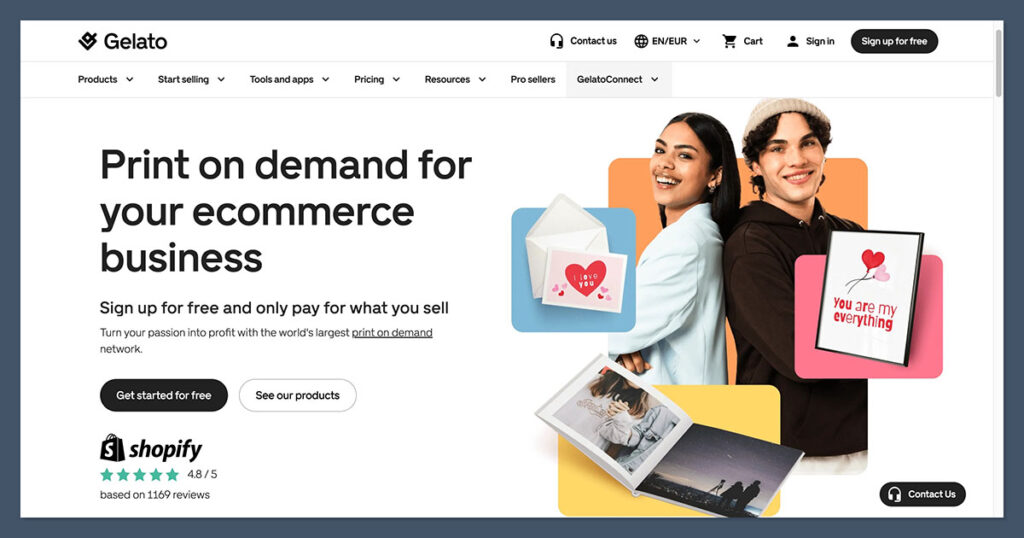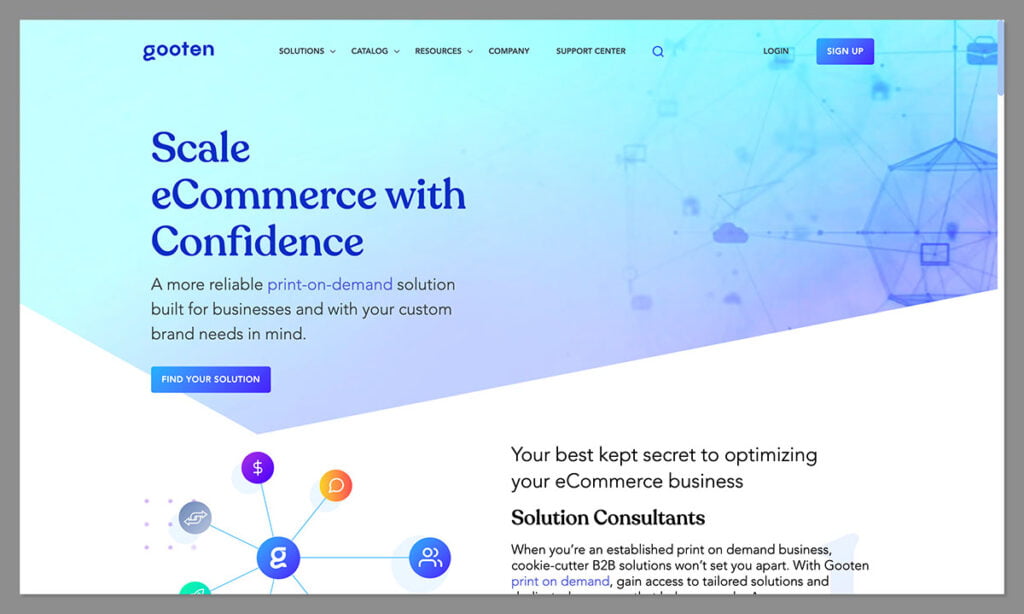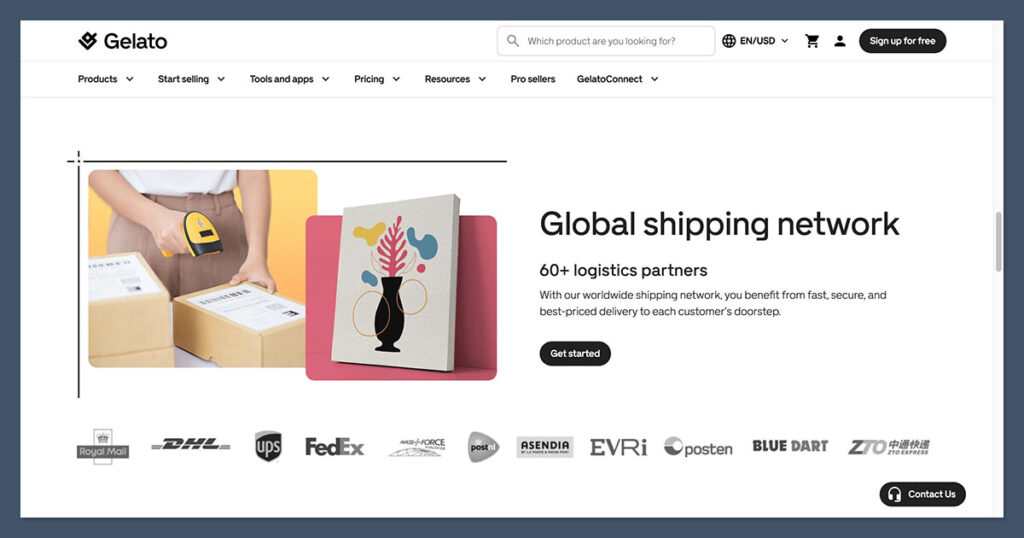Disclosure: We may earn a commission or fee from some of the links in our content. However, this does not affect our recommendations. Learn more.
We’ve spent over 100 hours using, testing, and comparing the best print-on-demand platforms for ecommerce stores.
And when it comes to Gelato vs Gooten, the differences are bigger than they look at first glance.
After running real stores on both platforms and reviewing supplier networks, integrations, pricing, fulfilment speed, and customer satisfaction — here’s what stood out.
Quick Verdict:
Gelato – Best for global fulfilment and professional-quality prints
Gooten – Best for wide product variety and flexible operations
I’ll break it all down based on what actually matters: fulfilment, pricing, integrations, product quality, and customer support.
Gelato vs Gooten: Quick Comparison
Here’s a snapshot of how Gelato and Gooten stack up:
| Feature | Gelato | Gooten |
|---|---|---|
| Overall Rating | 4.6 / 5 | 4.1 / 5 |
| Fulfilment Network | 130+ countries | US + international partners |
| Product Range | ~100 SKUs | 150+ SKUs |
| Production Speed | 1–3 business days | 2–5 business days |
| Integrations | Shopify, Etsy, WooCommerce, Wix | Shopify, Etsy, WooCommerce, BigCommerce |
| Branding Options | Branded labels & packing slips | Limited branding |
| API Access | Yes | Yes |
| Customer Support | Live chat & email | Email & support tickets |
| Best For | Global shipping & pro-quality products | Testing wide product variety |
| Free Plan | Yes | Yes |
1. Best for Product Range: Gooten Wins
Gooten offers a bigger product catalog with more niche options. If you’re selling baby products, pet beds, yoga mats, or kitchen items — you’ll find them here. That’s one of Gooten’s main selling points.
Gelato sticks to essentials: clothing basics, posters, mugs, calendars, wall art. The range is smaller, but the quality control is higher and everything feels polished.

Another edge with Gooten is its regular addition of new products.
They tend to roll out seasonal and trend-based items faster, which is useful if you want to catch viral trends or keep your store feeling fresh. You’re not locked into a rigid catalog.

They also offer variant-rich products. For example, many SKUs have extended size, colour, and material options — especially in categories like homeware and apparel. That gives sellers more flexibility without needing to create new listings.
On the flip side, Gelato’s smaller catalog means fewer options but less clutter. Everything feels purpose-built.
Their posters, photo books, and stationery products are some of the best in class — ideal for artists or photographers who prioritise quality and presentation.
Gooten Pros:
- Over 150 products across multiple categories
- Niche items like puzzles, blankets, and accessories
- Ideal for stores testing unique products
Gelato Pros:
- Tight, curated catalog
- Products available globally
- Consistent look and feel
Verdict: Gooten is better if product variety is your focus.
If you want to scale with fewer SKUs and more consistent fulfilment, Gelato is still a strong contender.
2. Best for Fulfilment Speed & Network: Gelato Wins
Gelato has one of the most impressive POD fulfilment networks in the world. With printing hubs in 130+ countries, your product gets printed locally and shipped faster — often in 1–3 business days.

Gooten still offers decent speed, but most of its production is US-based or via global partners.
That means international orders take longer and sometimes get hit with customs fees.
In testing, I found Gelato’s fulfilment times consistent regardless of the destination.
Orders to the UK, Germany, and Canada all arrived within three to five business days, which is impressive for POD. Their local printing model cuts down on shipping delays and improves tracking visibility.
Gooten performed best with US orders. Domestic orders were fast, but as soon as I shipped to Australia or parts of Europe, the delays became noticeable — with some deliveries taking 7–10 days.
That might work for US-only stores, but international sellers should be cautious.
The added benefit with Gelato is lower emissions due to local production. If sustainability is part of your brand positioning, their setup is much easier to promote — and that matters more to customers now than ever.
Gelato Pros:
- Global network = faster shipping
- Local production = lower carbon footprint
- Real-time tracking with most orders
Gooten Cons:
- Slower fulfilment on international orders
- Less transparency on partner locations
Verdict: Gelato is the clear winner for global fulfilment.
If your customers are spread across the US, Europe, and beyond — Gelato’s speed and scalability are hard to beat.
3. Best for Integrations & Platform Support: It’s a Tie
Both platforms integrate with the usual suspects — Shopify, WooCommerce, Etsy — and offer open API access for custom workflows. Gooten has slightly more native integrations, including BigCommerce and Order Desk.
But Gelato wins on ease of setup. Their interface is cleaner, and the onboarding process is smoother. Everything’s clearly explained, and customer data flows well between systems.
One feature I really appreciated in Gelato is how quickly you can push products live across channels.
The sync works seamlessly, and you get clear error messaging if anything goes wrong with variants or image resolutions.
Gooten gives developers a bit more flexibility on the backend. Their API is well-documented and can support custom workflows for automation, advanced routing, or CRM integrations.
That’s helpful if you have a technical team or use middleware like Zapier or Alloy.
The only downside with both platforms is the limited depth in non-Shopify integrations. If you’re using Squarespace, Wix, or another non-standard builder, you’ll likely have to connect through manual feeds or workarounds.
Integration Table:
| Platform | Shopify | Etsy | WooCommerce | Wix | BigCommerce | Custom API |
|---|---|---|---|---|---|---|
| Gelato | ✅ | ✅ | ✅ | ✅ | ❌ | ✅ |
| Gooten | ✅ | ✅ | ✅ | ❌ | ✅ | ✅ |
Verdict: If you’re building on Shopify or Etsy, either will work.
If you’re using BigCommerce, Gooten has an edge. For user experience and faster setup, Gelato comes out slightly ahead.
4. Best for Branding & Packaging: Gelato Wins
Gelato supports more branding features than Gooten. With their Gelato+ plan, you can add branded labels, packing slips, and inserts to your orders. This is huge for brand-first businesses.
Gooten doesn’t offer much beyond a basic white-label experience. There are no custom inserts or packaging options, which limits your ability to stand out post-purchase.
Custom branding isn’t just a vanity feature — it affects how memorable your brand is. Gelato allows you to upload your logo, set sender details, and even customise packaging in some regions. It’s a strong advantage for repeat purchases.
When I tested Gooten, all the orders arrived in plain packaging. There was no trace of branding, and no option to include marketing inserts or thank-you cards. That might be fine for bulk dropshipping, but it doesn’t work well if you’re building a brand.
Brand perception matters. If you’re selling $40 canvas prints or apparel, customers expect the packaging to match the price tag. Gelato gives you that opportunity — and it’s worth the extra cost.
Gelato Branding Options:
- Branded packing slips
- Custom sender address
- White-label everything
- Add company logo to deliveries
Gooten Branding Options:
- White-label by default
- No custom packaging or inserts
Verdict: Gelato wins for brand control.
If you’re serious about brand building, this is a big deal.
5. Best for Quality Control & Product Consistency: Gelato Wins
One of Gelato’s strengths is quality control. Every product is printed using consistent materials and machines across their global network. That means you don’t get the variation in colour, sizing, or print quality you sometimes see with Gooten.
Gooten relies heavily on third-party production partners. That gives them range, but the downside is inconsistent results — especially across regions.
With Gelato, I tested t-shirts, mugs, and posters across different fulfilment centres. The results were nearly identical. Print sharpness, colour consistency, and packaging met expectations every time — and customers noticed the difference.
Gooten’s inconsistency was more apparent when sending orders to customers in different countries. One customer in the US received a vibrant print; another in Europe got one with slightly faded colours. Support helped, but it’s still a customer service cost you have to absorb.
Consistency builds trust. If you want customers to order again — or refer their friends — they need to know they’ll get the same great product every time. Gelato’s system makes that much easier.
Real Experience:
- I ran identical print campaigns on both platforms.
- Gelato delivered sharper prints, more accurate colour matching, and better packaging every single time.
- Gooten had more returns due to misprints and colour differences.
Verdict: Gelato offers higher product consistency.
If your store sells artwork or high-ticket apparel, Gelato gives you more control over customer satisfaction.
6. Best for Pricing & Margins: It’s a Tie (But Depends)
Gelato’s base prices are slightly higher on average, but shipping is often cheaper because of local fulfilment. They also offer volume-based discounts on their Gelato+ plans.
Gooten’s prices are more flexible. Their “hybrid fulfilment” model lets you pick cheaper partners, which can give you better margins — but it’s a tradeoff with quality and speed.
Pricing also depends on how many SKUs you sell. Gelato gives you consistent pricing, but Gooten offers more variability. That means you could have great margins on some products, but tighter ones on others — especially custom items or heavy goods.
If you’re selling globally, Gelato’s local shipping brings your total landed cost down. That’s something people often miss — it’s not just the base product cost, but the shipping speed, fees, and customer satisfaction impact.
Gelato+ is worth considering if you’re doing volume. The subscription pays for itself quickly through shipping discounts, mockup tools, and branded assets.
| Product | Gelato Price | Gooten Price |
|---|---|---|
| Unisex T-Shirt | $9.95 + shipping | $8.50 + shipping |
| 11oz Mug | $7.90 | $6.95 |
| A3 Poster | $8.99 | $8.45 |
Key Costs to Watch:
- Gelato shipping varies by country, but is usually faster
- Gooten shipping can be higher and slower, especially overseas
- Both offer free plans, but Gelato+ adds features for ~$14.99/month
Verdict: Margins are similar, but Gooten gives you more pricing flexibility.
If quality is your top priority, Gelato justifies the slightly higher cost.
7. Best for Customer Support: Gelato Wins
Customer support might not seem like a big deal — until something breaks. I’ve contacted both platforms multiple times.
Gelato responds quickly via live chat and email, usually within hours. Their support team is professional, helpful, and available in multiple time zones.
With Gooten, I usually waited 24–48 hours for a reply. Most of the time, I got the answers I needed — but the lack of live chat made urgent issues harder to resolve. If something goes wrong during a major sales event, that lag time can hurt.
Gelato’s Help Center is also much more detailed. It’s packed with step-by-step guides, onboarding videos, and fulfilment troubleshooting. That saves time and reduces back-and-forth.
If you’re running ads or have time-sensitive campaigns, fast support matters. You want to resolve order issues within hours, not days — especially during Q4 or peak traffic seasons.
Support Table:
| Support Channel | Gelato | Gooten |
|---|---|---|
| Live Chat | ✅ | ❌ |
| Email Support | ✅ | ✅ |
| Knowledge Base | ✅ | ✅ |
| Priority Support | ✅ (Gelato+) | ❌ |
Verdict: Gelato has better support, especially if you’re operating at scale.
Faster answers = fewer headaches during busy seasons.
Gelato vs Gooten: Our Winner
For ecommerce brands focused on quality, speed, and global reach, Gelato is the better print-on-demand platform. Its fulfilment network, consistent product quality, and branding tools make it ideal for scaling a long-term store.
Gooten holds its own with a larger product catalog and flexible supplier model, giving it an edge for sellers who want to test a wide variety of niche products at competitive prices.
While Gelato is our top pick overall, it’s worth trying both platforms to see which one fits your business model best — especially if you’re balancing quality with product diversity.

